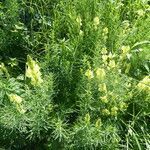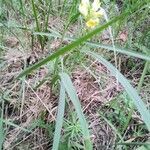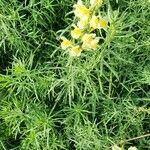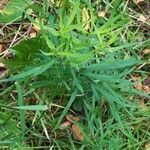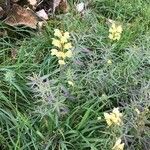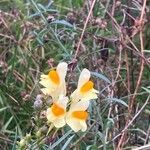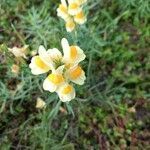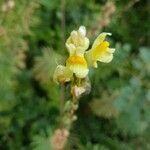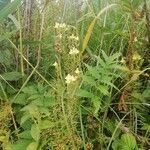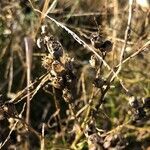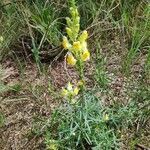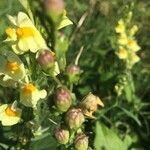Much-branched perennial with stout rootstock or rhizome; stems many, to c. 60 cm tall, glabrous or sometimes puberulent. Lvs 2-5 cm × c. 1.5-(5) mm, linear, glabrous, glaucous; apex acute. Infl. dense and many-flowered. Bracts linear to lanceolate, glabrous or minutely puberulent, > pedicels. Calyx 3-5 mm long, deeply lobed; lobes ovate, acute. Corolla 25-35 mm long (including the narrow spur 10-15 mm long), yellow with broad orange patch on and around pouch; upper lip 15-20 mm long. Capsule 8-10 × 5-7 mm, ellipsoid. Seed 1.5-2 mm diam. (including broad wing), broad-ellipsoid to orbicular, black, minutely tuberculate.
Perennial herb, up to 0.9 m high; stems ± erect, simple or branched at base or above in racemes, glabrous but sometimes glandular-pubescent in inflorescence. Leaves mostly alternate, crowded, up to 60 x 5(-15) mm, ± linear or narrowly elliptical or ± oblanceolate, acute. Flowers pale to strong yellow, palate usually orange, pedicellate, bilabiate, in crowded, bracteate racemes of up to 30 flowers. Calyx up to 6 mm long. Corolla up to 33 mm long; tube up to 10 mm wide at mouth. Spur conical, 10-13 mm long, acute. Flowering time Dec. Seeds ± spherical, black, tuberculate.
Perennial herb, 0.25-0.92 m high. Stems erect, simple or branched at base or above in racemes, glabrous, sometimes glandular-pubescent in inflorescence. Leaves opposite, verticillate or mostly alternate; sessile; blade sublinear, narrowly elliptical or oblanceolate, 20-60 x 1-5(-15) mm, apex acute, margins entire. Flowers: in dense, terminal racemes; spur conical, 10-13 mm long, acute, corolla tube 19-33 mm long, 10 mm wide at mouth; corolla yellow, palate usually orange, bearded; Oct.-Dec.
A medium sized tufted herb. It grows 25-75 cm tall. It keeps growing from year to year. The rootstock is creeping or has rhizomes. The stems are erect or curve upwards. The stems usually branch in the upper half. The leaves are narrow and crowded. They are alternate and simple. They are 2-7.5 cm long. They have one vein. The flowers are yellow. They are 25-33 mm long and in long dense racemes. The spur is 10-13 mm long and straight. One plant can produce 30,000 very small seeds.
Perennial, 3–8 dm, colonial by creeping roots; lvs very numerous, pale green, 2–5 cm × 2–4 mm, narrowed below to a petiole-like base; fls numerous in a compact spike, yellow with orange palate, 2–3.5 cm, including the spur; fr round-ovoid, 8–12 mm; seeds winged; 2n=12. Native of Europe, established in fields, roadsides, and waste places throughout temperate N. Amer. May–Sept. (L. linaria)
Herb, up to 250 mm tall. Leaves opposite, verticillate or alternate, sublinear, sessile, entire. Flowers arranged in dense, terminal racemes, spurred. Flowers yellow.
